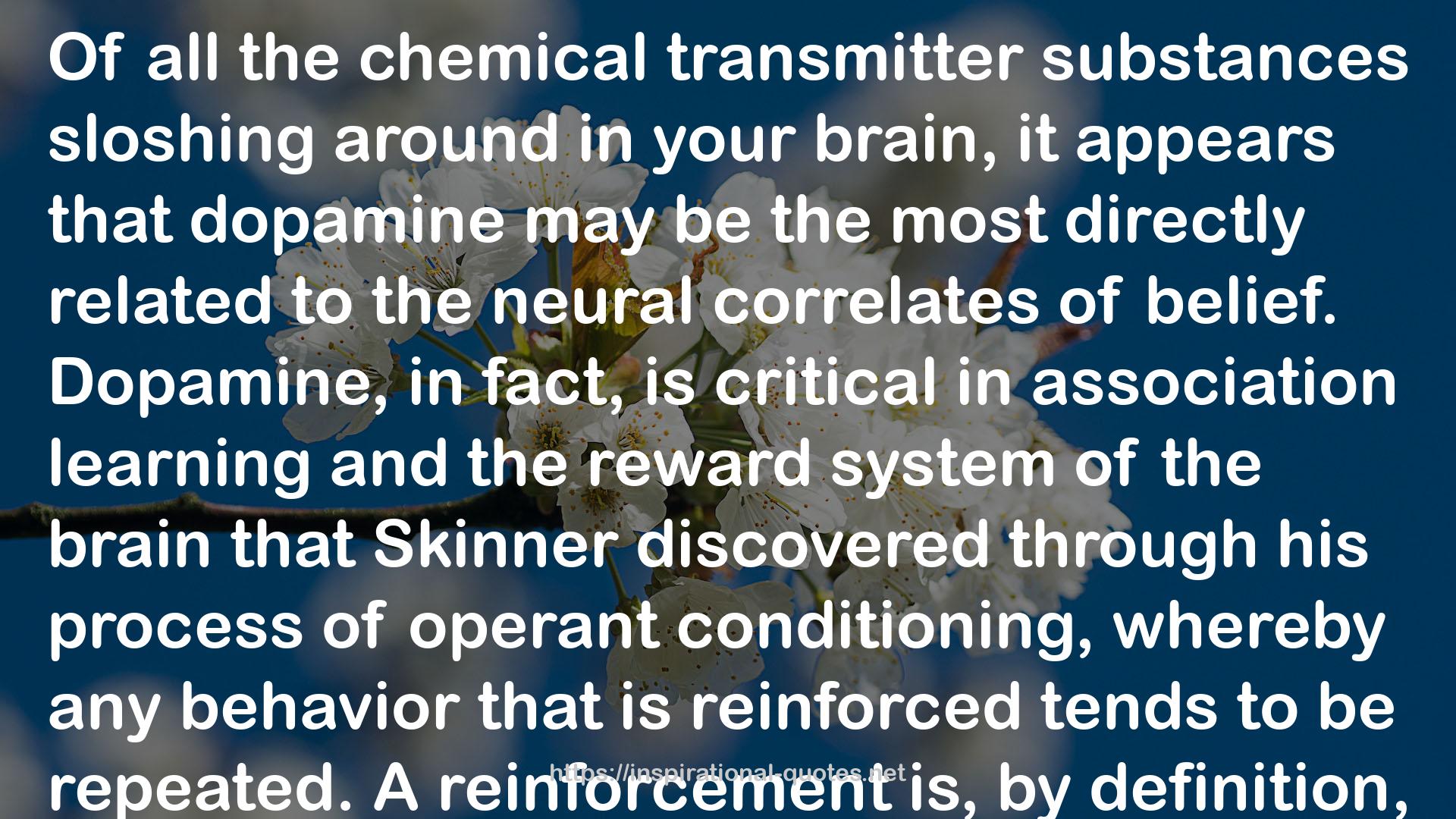6
" What is the probability that Yahweh is the one true god, and Amon Ra, Aphrodite, Apollo, Baal, Brahma, Ganesha, Isis, Mithra, Osiris, Shiva, Thor, Vishnu, Wotan, Zeus, and the other 986 gods are false gods? As skeptics like to say, everyone is an atheist about these gods; some of us just go one god further. "
― Michael Shermer , The Believing Brain: From Ghosts and Gods to Politics and Conspiracies How We Construct Beliefs and Reinforce Them as Truths
8
" The postmodernist belief in the relativism of truth, coupled with the clicker culture of mass media, in which attention spans are measured in New York minutes, leaves us with a bewildering array of truth claims packaged in infotainment units. It must be true—I saw it on television, the movies, the Internet. The Twilight Zone, The Outer Limits, That’s Incredible!, The Sixth Sense, Poltergeist, Loose Change, Zeitgeist: The Movie. Mysteries, magic, myths, and monsters. The occult and the supernatural. Conspiracies and cabals. The face on Mars and aliens on Earth. Bigfoot and Loch Ness. ESP and psi. UFOs and ETIs. OBEs and NDEs. JFK, RFK, and MLK Jr.—alphabet conspiracies. Altered states and hypnotic regression. Remote viewing and astroprojection. Ouija boards and tarot cards. Astrology and palm reading. Acupuncture and chiropractic. Repressed memories and false memories. Talking to the dead and listening to your inner child. It’s all an obfuscating amalgam of theory and conjecture, reality and fantasy, nonfiction and science fiction. Cue dramatic music. Darken the backdrop. Cast a shaft of light across the host’s face. Trust no one. The truth is out there. I want to believe. "
― Michael Shermer , The Believing Brain: From Ghosts and Gods to Politics and Conspiracies How We Construct Beliefs and Reinforce Them as Truths
17
" Dr. Mark Crisplin, a Portland, Oregon, ER doctor, reviewed the original EEG readings of a number of patients claimed by the scientists as being flatlined or “dead” and discovered that this was not at all the case. “What they showed was slowing, attenuation, and other changes, but only a minority of patients had a flat line, and it [dying] took longer than 10 seconds. The curious thing was that even a little blood flow in some patients was enough to keep EEGs normal.” In fact, most cardiac patients were given CPR, which by definition delivers some oxygen to the brain (that’s the whole point of doing it). Crisplin concluded: “By the definitions presented in the Lancet paper, nobody experienced clinical death. No doctor would ever declare a patient in the middle of a code 99 dead, much less brain dead. Having your heart stop for 2 to 10 minutes and being promptly resuscitated doesn’t make you ‘clinically dead.’ It only means your heart isn’t beating and you may not be conscious.”31 Again, since our normal experience is of stimuli coming into the brain from the outside, when one part of the brain abnormally generates these illusions, another part of the brain—quite possibly the left-hemisphere interpreter described by neuroscientist Michael Gazzaniga—interprets them as external events. Hence, the abnormal is interpreted as supernormal or paranormal. "
― Michael Shermer , The Believing Brain: From Ghosts and Gods to Politics and Conspiracies How We Construct Beliefs and Reinforce Them as Truths
20
" The connection between dopamine and belief was established by experiments conducted by Peter Brugger and his colleague Christine Mohr at the University of Bristol in England. Exploring the neurochemistry of superstition, magical thinking, and belief in the paranormal, Brugger and Mohr found that people with high levels of dopamine are more likely to find significance in coincidences and pick out meaning and patterns where there are none. In one study, for example, they compared twenty self-professed believers in ghosts, gods, spirits, and conspiracies to twenty self-professed skeptics of such claims. They showed all subjects a series of slides consisting of people’s faces, some of which were normal while others had their parts scrambled, such as swapping out eyes or ears or noses from different faces. In another experiment, real and scrambled words were flashed. In general, the scientists found that the believers were much more likely than the skeptics to mistakenly assess a scrambled face as real, and to read a scrambled word as normal.
In the second part of the experiment, Brugger and Mohr gave all forty subjects L-dopa, the drug used for Parkinson’s disease patients that increases the levels of dopamine in the brain. They then repeated the slide show with the scrambled or real faces and words. The boost of dopamine caused both believers and skeptics to identify scrambled faces and real and jumbled words as normal. This suggests that patternicity may be associated with high levels of dopamine in the brain. Intriguingly, the effect of L-dopa was stronger on skeptics than believers. That is, increased levels of dopamine appear to be more effective in making skeptics less skeptical than in making believers more believing.8 Why? Two possibilities come to mind: (1) perhaps the dopamine levels of believers are already higher than those of skeptics and so the latter will feel the effects of the drug more; or (2) perhaps the patternicity proclivity of believers is already so high that the effects of the dopamine are lower than those of skeptics. Additional research shows that people who profess belief in the paranormal—compared to skeptics—show a greater tendency to perceive “patterns in noise,”9 and are more inclined to attribute meaning to random connections they believe exist. "
― Michael Shermer , The Believing Brain: From Ghosts and Gods to Politics and Conspiracies How We Construct Beliefs and Reinforce Them as Truths
 The Believing Brain: From Ghosts and Gods to Politics and Conspiracies How We Construct Beliefs and Reinforce Them as Truths
The Believing Brain: From Ghosts and Gods to Politics and Conspiracies How We Construct Beliefs and Reinforce Them as Truths